
Biology (6)
Column Matrix

A matrix is said to be a column matrix if it has only one column. In general, a = [aij] m x 1 is a column matrix of order m x 1
For example: 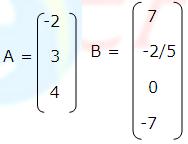
Order of A is 3 x 1 and that of B is 4 x 1
Row Matrix
A matrix is said to be a row matrix if it has only one row. In general, B = [bij] 1 x n is a row matrix of order 1 x n
For example: A = [2 0 5 -3] B = [1/2 0 √3 6 7]
Here order of A is 1 x 4 and that of B is 1 x 5
Square Matrix
A matrix whose numbers of columns are equal to number of rows is said to be a square matrix. Thus an m x n matrix is said to be a square matrix if m = n and is known as a square matrix of order ‘n’.
For example: 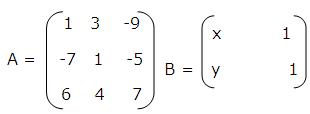
Hence A is of order 3 and B is of order 2.
Diagonal Matrix
A square matrix B = [bij]mxm is said to be a diagonal matrix if all its non diagonal elements are zero.
For example: 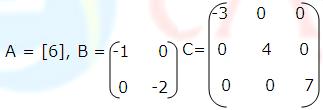
Hence the orders of A, B and C are 1,2 and 3 respectively
Scalar Matrix
A diagonal matrix is said to be a scalar matrix if its diagonal elements are equal.
That is bij = 0, when i ≠ j
bij = k, when i = j, for some constant k
For example: 
Hence the order of A, B and C are 1, 2 and 3 respectively.
Identity Matrix
A square matrix in which elements in the diagonal are all 1 and rest all are zero is called and identity matrix. In other words, the square matrix A =

Zero Matrix
A matrix is said to be a zero matrix if all its entries are zero. Another name for zero matrix is null matrix. It is denoted by 0.
For example: 
The orders of the above matrices are 1 x 1, 2 x 2 and 2 x 3 respectively.
Now try it yourself! Should you still need any help, click here to schedule live online session with e Tutor!
About eAge Tutoring:
eAgeTutor.com is the premium online tutoring provider. Using materials developed by highly qualified educators and leading content developers, a team of top-notch software experts, and a group of passionate educators, eAgeTutor works to ensure the success and satisfaction of all of its students.
Contact us today to learn more about our tutoring programs and discuss how we can help make the dreams of the student in your life come true!
Reference Links:
- http://simple.wikipedia.org/wiki/Matrix_(mathematics)#One_column_matrix
- http://en.wikipedia.org/wiki/Row_matrix
- http://www.britannica.com/EBchecked/topic/561660/square-matrix
- http://en.wikipedia.org/wiki/Diagonal_matrix
- http://en.wikipedia.org/wiki/Diagonal_matrix#Scalar_matrix
- http://en.wikipedia.org/wiki/Identity_matrix
- http://en.wikipedia.org/wiki/Zero_matrix
- Column Matrix
- Row Matrix
- Square Matrix
- Diagonal Matrix
- Scalar Matrix
- Identity Matrix
- Zero Matrix
- Solved Examples
- Homework Help
- Math Tutoring
- Math Help
- Math Articles
- Matrices – Introduction
- More About Matrices
- Multiplication of Matrices
- Addition and Subtraction of Matrices
- Adjoint and Inverse of a Matrix
- Equality of matrices
- Invertible Matrices
- Solution of a system of linear equations
- Symmetric and skew symmetric matrices
- Determinants
- Properties of Determinants
Introduction to electric motors
An electric motor is all about magnets and magnetism. An electric motor uses magnets to create motion. You know the law of magnets: opposite poles attract and like poles repel. So if you have two bar magnets with their ends marked "north" and "south," then the north end of one magnet will attract the south end of the other. On the other hand, the north end of one magnet will repel the north end of the other. Inside an electric motor, these attracting and repelling forces create rotational motion.
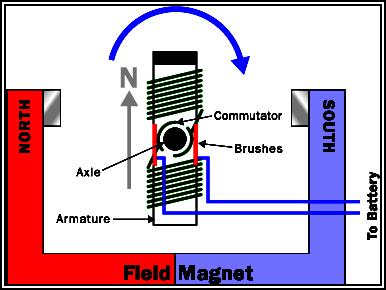
What is an electric motor?
An electric motor is an electromechanical device that converts electrical energy to mechanical energy. This mechanical energy is used, for example, to rotate a pump impeller, fan or blower, drive a compressor, lift materials etc. Electric motors are sometimes called the “work horses” of industry; it is estimated that motors use about 70% of the total electrical load in industry.
Components of electric motors
If you take apart a small electric motor, you will find that it contains the following: two small permanent magnets inside casing, two brushes held in housing, and an electromagnet that is made by winding wire around pieces of shaped metal (laminations) on a steel shaft, known as an armature or rotor. The rotor will almost always have three poles or more, and there are two good reasons this:
1. Having three or more poles causes the motor to have better dynamics (movement). In a two-pole motor, if the electromagnet is at the balance point, which is perfectly horizontal between the two poles of the field magnet when the motor starts, you can imagine the armature getting "stuck" there. That never happens in a three-pole motor, which can start turning from any starting position.
2. Each time the commutator hits the point where it flips the field in a two-pole motor, the commutator temporarily shorts out the battery (i.e., it directly connects the positive and negative terminals). This shorting wastes energy and needlessly drains the battery. A three-pole motor solves this problem. In fact, an efficient motor’s timing switches on the armature when the magnetic repulsion is strongest.
An electric motor can have any number of poles, depending on the size of the motor and its specific application. Motors come in different shapes and sizes to fit almost anywhere.
Types of Electric Motors

How does an electric motor work?
The general working mechanism is the same for all electric motors (see first figure above):
a) An electric current in a magnetic field will experience a force.
b) If the wire that carries current is bent into a loop, then the two sides of the loop, which are at right angle to the magnetic field, will be forced in opposite directions.
c) The pair of forces creates a turning torque to rotate the coil.
d) Practical motors have several loops on an armature to provide a more uniform torque. The magnetic field is produced by electromagnet arrangement called the field coils.
.
Want to know more about electric motors? Click here to schedule a live session with an eAge eTutor!
About eAge Tutoring:
eAgeTutor.com is the premium online tutoring provider. Using materials developed by highly qualified educators and leading content developers, a team of top-notch software experts, and a group of passionate educators, eAgeTutor works to ensure the success and satisfaction of all of its students.
Contact us today to learn more about our guaranteed results and discuss how we can help make the dreams of the student in your life come true!
Reference links:
- Current-carrying conductors
- Magnetic field
- Electromagnet Electrical energy
- Mechanical energy
- Bar magnet
- Motion
- Armature
- Rotor
- Stator
- Axle
- Windings
- Commutator
- Electricity Help
- Electricity Tutoring
- Electricity Diagram
- What is Electricity?
- Physics Help
- Physics Tutoring
- Physics Articles
- Capacitor
- Parallel plate capacitor
- Electric Dipole
- Electric current
- Electric Potential
- Electric circuit
- Resistance
- Resistivity and Conductivity
- EMF and Internal resistance
- AC and DC current
- Thermocouple
- Wheatstone bridge
- Kirchoff’s law
- Potentiometer
- Sources of current
- Magnetic field
- Magnetic field due to solenoid
- Electromagnetic induction
- Fleming’s right hand rule
- Electric bell
- Sources of current
- Thermocouple
- Seebeck effect
- Thomson effect
- Thermoelectricity.
Introduction to AC and DC Current
 AC means “Alternating Current” and DC means “Direct Current.” AC and DC are also used when referring to voltages and electrical signals, which are not currents. DC is electricity flowing in a constant direction, and/or possessing a voltage with constant polarity.
AC means “Alternating Current” and DC means “Direct Current.” AC and DC are also used when referring to voltages and electrical signals, which are not currents. DC is electricity flowing in a constant direction, and/or possessing a voltage with constant polarity.
DC is the kind of electricity that a battery with definite positive and negative terminals makes, or the kind of charge that is generated by rubbing certain types of materials against each other. Certain sources of electricity (most notably, rotary electro-mechanical generators) naturally produce voltages that alternate in polarity, reversing positive and negative over time. Either as a voltage switching polarity or as a current switching direction back and forth, this "kind" of electricity is known as Alternating Current (AC).
What is Alternating Current (AC)
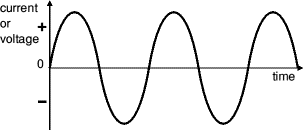 Alternating Current (AC) flows one way, then the other way, continually reversing direction. An AC voltage is continually changing between positive (+) and negative (-). The rate of changing direction is called the frequency of the AC and it is measured in hertz (Hz), which is the number of forwards-backwards cycles per second. An AC supply is suitable for powering some devices such as lamps and heaters but almost all electronic circuits require a steady DC supply.
Alternating Current (AC) flows one way, then the other way, continually reversing direction. An AC voltage is continually changing between positive (+) and negative (-). The rate of changing direction is called the frequency of the AC and it is measured in hertz (Hz), which is the number of forwards-backwards cycles per second. An AC supply is suitable for powering some devices such as lamps and heaters but almost all electronic circuits require a steady DC supply.
This shape portraying AC from a power supply is called a sine wave. Alternating current is the most common form used in the transmission of electricity from power plants to homes and businesses. It is convenient because the voltage can be changed easily with transformers. High voltage is good for long-distance transmission of electricity because it means less current has to flow to achieve the same amount of power, and power is lost in the resistance of wires in proportion to the square of the current. Alternating current is generated at the power station by rotating a coil of wire inside a big magnet. The energy needed to make the coil turn is provided by burning fuels such as coal, oil, natural gas, or by harnessing air, water, or nuclear power to do it. Faraday's law of induction relates the change in the voltage around the coil of wire to the rate of change of the amount of magnetic flux through the wire. If the wire turns around in circles, the voltage will be positive, then negative, then postitive again. Because the voltage swings back and forth between positive and negative values, at some times it crosses zero.
What is Direct Current (DC)
Direct Current (DC) always flows in the same direction, but it may increase and decrease. DC voltage is always positive (or always negative), but may increase and decrease. Electronic circuits normally require a steady DC supply which is constant at one value or a smooth DC supply which has a small variation called ripple.
Cells, batteries, and regulated power supplies provide steady DC which is ideal for electronic circuits.
Power supplies contain a transformer which converts the mains AC supply to a safe low voltage AC. The AC is then converted to DC by a bridge rectifier. However, the output is varying DC which is unsuitable for electronic circuits.
Direct current is very useful in powering small things such as flashlights and radios and toys. Batteries are the most common source of direct current -- the voltage of a battery is constant. Things that need lots of power in the form of direct current, like computers, have power supplies inside which transform alternating current from the wall plug to direct current. This way, they don’t run out of batteries.
Steady DC
from a battery or regulated power supply, this is ideal for electronic circuits.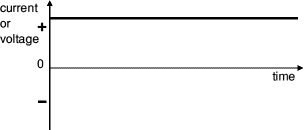
Smooth DC
from a smoothed power supply, this is suitable for some electronics
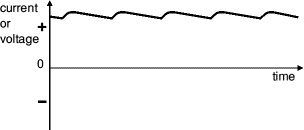
Want to know more about AC and DC current? Click here to schedule a live session with an eAge eTutor!
About eAge Tutoring:
eAgeTutor.com is the premium online tutoring provider. Using materials developed by highly qualified educators and leading content developers, a team of top-notch software experts, and a group of passionate educators, eAgeTutor works to ensure the success and satisfaction of all of its students.
Contact us today to learn more about our guaranteed results and discuss how we can help make the dreams of the student in your life come true!
Reference links:
- http://www.science.howstuffworks.com › ... › Physical Science › Electricity
- http://www.allaboutcircuits.com › ... › BASIC AC THEORY
- http://www.hyperphysics.phy-astr.gsu.edu/hbase/electric/elevol.html
- AC current
- DC current
- Voltage
- Electrical signal
- Frequency
- Hertz
- Electronic circuit
- Cell
- Battery Power supply
- Transformer
- Bridge rectifier
- Electricity Help
- Electricity Tutoring
- Electricity Diagram
- What is Electricity?
- Physics Help
- Physics Tutoring
- Physics Articles
- Capacitor
- Parallel plate capacitor
- Electric Dipole
- Electric current
- Electric Potential
- Electric circuit
- Resistance
- Resistivity and Conductivity
- EMF and Internal resistance
- AC and DC current
- Thermocouple
- Wheatstone bridge
- Kirchoff’s law
- Potentiometer
- Sources of current.
The ecosystem moves towards the climax community. A seral community is an intermediate stage in an ecosystem. Before attaining the climax community sometimes more than one seral stage can also evolve.
Depending on the substratum and climate, a seral community can be classified into water community, rock community, sand community, dry area community & saline body ommunity. This can be termed biologically as Hydrosere, Lithosere, Psammosere, Xerosere, and Halosere respectively.
Hydrosere
It is a plant succession occurs in a freshwater lake. If the water dried up it becomes the woodland. Because of this change the land types will succeed each other.

Mute Swan - Hydrosere Community
The Loch a' Mhuilin lake is located in the Isle of Arran, Scotland. The lake exhibits characteristic features of a hydrosere, the succession from a fresh water surface with small pioneer plant species to a sub-climax vegetation of alder and willow. Because of clearing grazing land by human activities and by red deer and rabbits, the climax vegetation of oak and Thomas beech woodland has not been achieved.
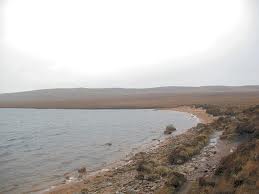
Loch a' Mhuilin Lake
Lithosphere
It is a plant succession that begins life on a newly exposed rock surface. Once the Laki and Katla fissures erupted, the lava fields of Eldgjá in Iceland began to form a lithosere.
Psammosere
An ecological succession began life on newly exposed coastal sand. Example: sand dune systems
Xerosere
It is limited by water availability with xerarch succession of ecological communities originated in extremely dry situation. Example: sand deserts, sand dunes etc.
Halosere
The succession occurs in a saline environment. Example: salt marsh
Note: A xerosere may include lithoseres and psammoseres
Climax Community
It is a biological community of plants and animals through the process of ecological succession
Want to know more about seral communities? Click here to schedule live online session with e Tutor!
About eAge Tutoring:
eAgeTutor.com is the premium online tutoring provider. Using materials developed by highly qualified educators and leading content developers, a team of top-notch software experts, and a group of passionate educators, eAgeTutor works to ensure the success and satisfaction of all of its students.
Contact us today to learn more about our tutoring programs and discuss how we can help make the dreams of the student in your life come true!
Reference Links:
- Seral community
- climax community
- Hydrosere
- swamp
- succession
- bioconstruction
- bullrushes
- dominance
- grazing land
- sub-climax vegetation
- xerosere
- halosere
- climax community
- Ecological succession
- freshwater
- organic matter
- nutrient exchange
- Ecology Help
- Ecology Tutoring
- Ecology Articles
- Biology Help
- Biology Tutoring
- Biology Articles
- Biogeochemistry
- The Carbon Cycle
- The Water Cycle
- Nitrogen Cycle
- Oxygen Cycle
- Phosphorous Cycle
- Food Chains and Webs
- Deforestation
- Air Pollution
- Water Pollution
- Environmental Issues
- Global Warming
- Solid Wastes
- Biomagnification
- Biosphere
- Food Web
- Decomposer
- Environmental Impact of Fertilizer
- Environmental Impact of Pesticides
- Ecological Impact of Farming.
Gene – The Hereditory Material
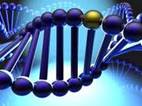 Gene is a nucleic acid segment which contains the genetic information necessary to produce a protein. Genes have a long strand of DNA with a promoter. This promoter controls the gene activity and a coding sequence.
Gene is a nucleic acid segment which contains the genetic information necessary to produce a protein. Genes have a long strand of DNA with a promoter. This promoter controls the gene activity and a coding sequence. 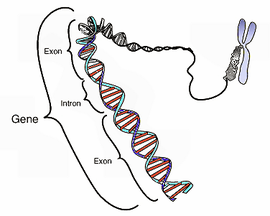 The gene coding determines what the gene produces. The informations present in the genes pass on to next generation. The organelle mitochondria self-replicate and they are not coded for by the organism's DNA.
The gene coding determines what the gene produces. The informations present in the genes pass on to next generation. The organelle mitochondria self-replicate and they are not coded for by the organism's DNA.
Genes and its Bases
The genes are having 4 nucleotide bases and hence named as polynucletides. Each nucleotide made up of a base group, a sugar and one ore phosphate groups.
- Adenine(A)
- Thymine (T)
- Guanine (G)
- Cytosine (C).
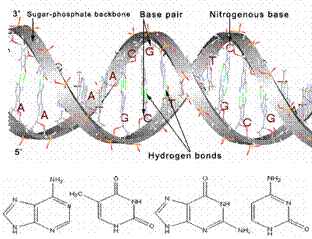
• The bases Adenine(A) and Guanine(G) are Purines
• Thymine (T) and Cytosine (C) are Pyrimidines.
Base Pairs
The sugar group is the backbone of DNA. The phosphate group links one nucleotide to another. The nitrogenous bases holds each other with the help of complimentary bases. Adenine is complimentary to Thymine while Guanine is complimentary to Cytosine. A forms 2 hydrogen bonds with T while G forms 3 hydrogen bonds with C.

So the G≡C bond is more stable than an A=T bond.
Definition of Gene
The gene is a "A locatable region of genomic sequence, corresponding to a unit of inheritance, which is associated with regulatory regions, transcribed regions, and or other functional sequence regions"
Gene may refer to an allele:
• A gene is the basic instruction, a sequence of nucleic acid
• An allele is one variant of that gene.
The genetic changes can be observed in the single letter of the genetic code and this change is termed as ‘ a single nucleotide polymorphism’.
The expression of genes
The gene expressions encoded in DNA. It begins by the transcription process into RNA. RNA contains the nitrogenous base – uracil in place of thymine of DNA. RNA molecules are single stranded and thus they are less stable than DNA.
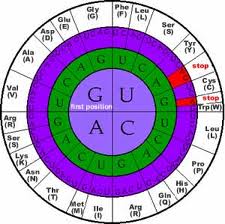 Genetic Code
Genetic Code
Genes that encode proteins are composed of codons. The codons are the series of three-nucleotide sequences. For example AUG, AGG etc.This is the gene lanugauge and it is alomost same for all organisms.
Want to know more about Genes? Click here to schedule a live help with an eTutor!
About eAge Tutoring
eAgeTutor.com is the premium online tutoring provider. Using materials developed by highly qualified educators and leading content developers, a team of top-notch software experts, and a group of passionate educators, eAgeTutor works to ensure the success and satisfaction of all of its students.
Contact us today to learn more about our guaranteed results and discuss how we can help make the dreams of the student in your life come true!
- Gene
- Genetic code
- Nucleic acid
- DNA
- Hydrogen Bonds
- Nitorgenous bases
- Single Nucleotide Polymorphism
- RNA
- Genetic language
- A T G C
- Adenine
- Guanine
- Thymine
- Uracil
- Cytosine
- Transcription
- RNA retroviruses
- Gene Diagram
- Gene Pictures
- Gene Help
- Gene Tutoring
- What is Gene
- Biology Help
- Biology Tutoring
- Biology Articles
- Functional Structure of a gene
- Gene and Genome Organization
- What is Chromosome?
- Location Of a Gene
- Chromosomal Aberrations
- Human Genetic Variation
- Genes and Diseases
- What is a Gene Mutation and how do mutations occur?
- Kinds of Gene Mutation
- Causes of Gene Mutation
- Mendalian Inheritance
- Mendel’s Law
- Mendel's trait and Probability of Inheritance
- Inheritance pattern through generations
- Sex-Determination system
- Genetic Disorder
- Autosomal dominant and X-linked Genetic disorder
- Autosomal Recessive Genetic disorder
Sorry! we can't find requested page!
The page uou have requested cannot be found, but despite our computers looking very hard, we could not find it. What may have happened ?
- The link you clicked to arrive here has a typo in it
- Or somehow we removed that page, or gave it another name
- Or, quite unlikely for sure, maybe you typed it yourself and there was a little mistake
Please Contact Site Administrator for more information.




